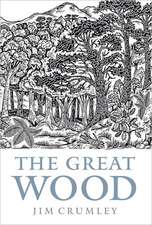Xanthomonas
Autor Jean Swings, Lucia Civettaen Limba Engleză Hardback – 30 sep 1993
| Toate formatele și edițiile | Preț | Express |
|---|---|---|
| Paperback (1) | 1222.49 lei 6-8 săpt. | |
| SPRINGER NETHERLANDS – 20 sep 2012 | 1222.49 lei 6-8 săpt. | |
| Hardback (1) | 1228.62 lei 6-8 săpt. | |
| SPRINGER NETHERLANDS – 30 sep 1993 | 1228.62 lei 6-8 săpt. |
Preț: 1228.62 lei
Preț vechi: 1498.31 lei
-18% Nou
Puncte Express: 1843
Preț estimativ în valută:
235.09€ • 256.17$ • 198.10£
235.09€ • 256.17$ • 198.10£
Carte tipărită la comandă
Livrare economică 23 aprilie-07 mai
Preluare comenzi: 021 569.72.76
Specificații
ISBN-13: 9780412434204
ISBN-10: 0412434202
Pagini: 399
Ilustrații: XIII, 399 p.
Dimensiuni: 155 x 235 x 24 mm
Greutate: 0.76 kg
Ediția:1993
Editura: SPRINGER NETHERLANDS
Colecția Springer
Locul publicării:Dordrecht, Netherlands
ISBN-10: 0412434202
Pagini: 399
Ilustrații: XIII, 399 p.
Dimensiuni: 155 x 235 x 24 mm
Greutate: 0.76 kg
Ediția:1993
Editura: SPRINGER NETHERLANDS
Colecția Springer
Locul publicării:Dordrecht, Netherlands
Public țintă
ResearchCuprins
1 The hosts of Xanthomonas.- 1.1 Introduction.- 1.2 Xanthomonas campestris pathovars on cassava: cause of bacterial blight and bacterial necrosis.- 1.3 Xanthomonas campestris pv. malvacearum: cause of bacterial blight of cotton.- 1.4 Xanthomonas oryzae pathovars on rice: cause of bacterial blight and bacterial leaf streak.- 1.5 Xanthomonas campestris pv. phaseoli: cause of common bacterial blight of bean.- 1.6 Xanthomonas campestris pv. glycines: cause of bacterial pustule of soybean.- 1.7 Xanthomonas campestris pv. citri: cause of citrus canker.- 1.8 Xanthomonas campestris pv. campestris: cause of black rot of crucifers.- 1.9 Xanthomonas campestris pv. graminis: cause of bacterial wilt of forage grasses.- 1.10 Xanthomonas campestris pv. vesicatoria: cause of bacterial spot of tomato and pepper.- 1.11 Xanthomonas campestris pv. pruni: cause of Prunus bacterial spot.- 1.12 Xanthomonas populi: cause of bacterial canker of poplar.- 1.13 Xanthomonas fragariae: cause of angular leaf spot of strawberry.- 1.14 Xanthomonas albilineans: cause of leaf scald of sugarcane.- 1.15 Xanthomonas campestris pathovars on cereals: cause of leaf streak or black chaff diseases.- 1.16 Xanthomonas campestris pv. pelargonii: cause of bacterial leaf spot and stem rot on Pelargonium spp..- 1.17 Xanthomonas campestris pv. hyacinthi: cause of yellow disease in Hyacinthus.- 1.18 Xanthomonas campestris pv. mangiferaeindicae: cause of bacterial black spot of mangoes.- References.- 2 The bacterium Xanthomonas.- 2.1 Introduction.- 2.2 The cell.- 2.3 Growth characteristics.- 2.4 Physiology and metabolism.- References.- 3 Taxonomy of the genus Xanthomonas.- 3.1 Introduction.- 3.2 Current status of the taxonomy of Xanthomonas.- 3.3 Phenetic basis of the taxonomy of Xanthomonas.- 3.4 Genetic basis of the classification.- 3.5 Perspectives for an improved taxonomy of Xanthomonas.- References.- 4 Infection of the plant by Xanthomonas.- 4.1 Epiphytic growth.- 4.2 Penetration.- 4.3 Initial events in pathogenesis.- 4.4 Multiplication and spread in the plant.- 4.5 Pathological manifestation.- 4.6 Bacterial determinants for virulence and/or pathogenicity.- 4.7 Plant-resistant reactions to xanthomonads.- 4.8 Effects of the environment.- References.- 5 Ecology of plant pathogenic xanthomonads.- 5.1 Introduction.- 5.2 Climatic conditions favourable for Xanthomonas.- 5.3 Life cycle.- 5.4 Epidemic development.- 5.5 Quantitative epidemiology.- References.- 6 Genetics of Xanthomonas.- 6.1 Introduction.- 6.2 Methodology.- 6.3 Properties of the Xanthomonas genome.- 6.4 Genes which are important for pathogenicity.- 6.5 The contribution of genetics to the understanding of bacteria-plant interactions.- References.- 7 Management of Xanthomonas diseases.- 7.1 Introduction.- 7.2 Seed health.- 7.3 Cultural practices.- 7.4 Chemical control.- 7.5 Host resistance.- 7.6 Conclusion.- References.- 8 Xanthan.- 8.1 Introduction.- 8.2 Structure of xanthan.- 8.3 Synthesis.- 8.4 Biosynthetic process.- 8.5 Physical properties of xanthan.- 8.6 Industrial usage of xanthan.- 8.7 Food uses of xanthan.- References.
Recenzii
`... the final (eighth) chapter by Sutherland provides an invaluable source of information about the synthesis, structure, industrial usage and food applications of the xanthan polymer... very clear and informative... useful general summary tables of vectors and properties of avirulence genes are given... useful discussion... this is a very successful compilation of authoritative and up-to-date reviews, and the editors have achieved a good blend of complementing chapters. The book will be of considerable value for teaching and research.... the text will not lose its usefulness quickly.'
Trends in Microbiology
`... an excellent overview of plant diseases caused by Xanthomonas, and gives an insight into the ecology and biology of this bacterium, as well as into genetic loci playing a role in the interaction with the plant...I believe that this very well-written book will be of great value to advanced students and to experts in both classical and molecular plant pathology, as well as to readers interested in plant-bacterium interactions.'
Plant Science
Trends in Microbiology
`... an excellent overview of plant diseases caused by Xanthomonas, and gives an insight into the ecology and biology of this bacterium, as well as into genetic loci playing a role in the interaction with the plant...I believe that this very well-written book will be of great value to advanced students and to experts in both classical and molecular plant pathology, as well as to readers interested in plant-bacterium interactions.'
Plant Science





